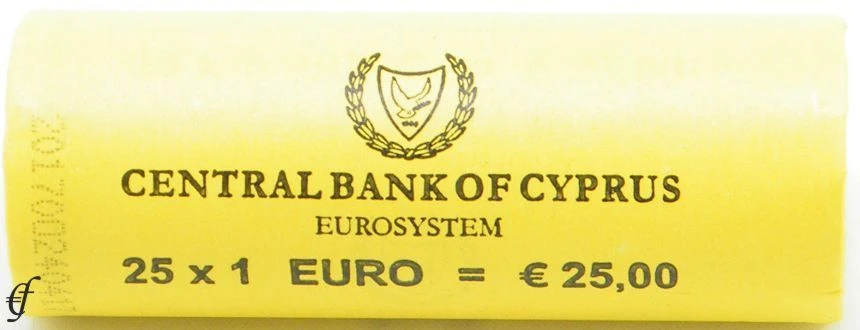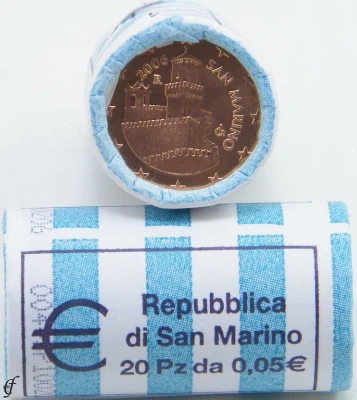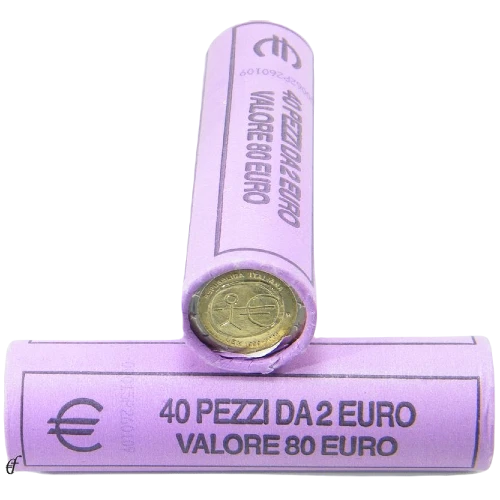A couple of days ago, I stumbled upon a small curiosity that may be obvious. Something that some of those who read me might already know, but that I had never noticed: euro coin rolls have a standardized color code throughout the Eurozone, which also matches the color of euro banknotes.
This adds to something I did know, which is that the amount of coins per roll is also standardized.
This European standardization probably stems from some internal memo of the European Central Bank, but I haven’t been able to find which one. I’ve asked the Bank of Spain, my local central bank, to see if they can help me find it. As soon as they reply, I’ll post it here.
In the meantime, let’s see what colors they are, some examples, and, finally, some exceptions that could give us a clue as to when the ECB’s internal circular was issued.
The colors
The colors of the rolls follow the same progression as the euro banknotes from highest to lowest, and they are:
- 2 Euro Roll: Purple, like the 500 euro banknote
- 1 Euro Roll: Yellow, like the 200 euro banknote
- 50 Cent Roll: Green, like the 100 euro banknote
- 20 Cent Roll: Orange, like the 50 euro banknote
- 10 Cent Roll: Blue, like the 20 euro banknote
- 5 Cent Roll: Red, like the 10 euro banknote
- 2 Cent Roll: Grey, like the 5 euro banknote
- 1 Cent Roll: White
Let’s see examples of each:
1 Cent Rolls
1 cent rolls contain 50 coins, totaling a value of 0.50 euros per cartridge. The identifying color is white.
Here is a roll of 2004 1 cent coins from Italy:

And this one is a roll of 2013 1 cent coins from Malta:

2 Cent Rolls
2 cent rolls contain 50 coins, totaling a value of 1 euro per cartridge. The identifying color is grey, similar to the 5 euro banknotes.
Here is a cartridge with 2018 2 cent coins from Estonia:

And this one is a roll of 2010 2 cent coins from Luxembourg:

5 Cent Rolls
5 cent rolls contain 50 coins, totaling a value of 2.50 euros per cartridge. The identifying color is red, akin to the 10 euro banknotes.
Here is a roll of 2012 5 cent coins from Belgium:

And this one is a roll of 2019 5 cent coins from Slovenia:

10 Cent Rolls
10 cent rolls contain 40 coins, totaling a value of 4 euros per cartridge. The identifying color is blue, akin to the 20 euro banknotes.
Here is a roll of 2011 10 cent coins from Finland:

And this one is a roll of 1999 10 cent coins from the Netherlands:

20 Cent Rolls
20 cent rolls contain 40 coins, totaling a value of 8 euros per cartridge. The identifying color is orange, akin to the 50 euro banknotes.
Here are the 2008 20 cent coins from San Marino:

And these are the 2020 20 cent coins from Germany, minted at Berlin (Mint A):

50 Cent Rolls
50 cent rolls contain 40 coins, totaling a value of 20 euros per cartridge. The identifying color is green, akin to the 100 euro banknotes.
Here is a roll of 2019 50 cent euro coins from Greece:

And this one is a bag of 2000 50 cent coins from Spain, with green bands across the plastic:
1 Euro Rolls
1 euro rolls contain 25 coins, totaling a value of 25 euros per cartridge. The identifying color is yellow, akin to the 200 euro banknotes.
Here is a roll of 2016 1 euro coins from Austria:

And this one is a roll of 2018 1 euro coins from Cyprus:

2 Euro Rolls
2 euro rolls contain 25 coins, totaling a value of 50 euros per cartridge. The identifying color is purple, akin to the 500 euro banknotes.
Here is a roll of the 2005 commemorative 2 euro coin from Spain dedicated to Don Quixote:

And this is a roll of the 2017 commemorative 2 euro coin from France dedicated to the Pink Ribbon:

As you can see, regardless of the country, the color code is there. However, while searching for images for this article, I have found two exceptions to these standard color codes and sizes, which could give us a clue as to when it was established.
The exceptions
The first of the two exceptions are the San Marino rolls of 1, 2, and 5 cents from 2006, which are white with blue bands, regardless of the denomination. Additionally, instead of containing 50 pieces per roll, they only carry 20, resulting in a rather chubby appearance.

The second exception lies in the commemorative 2 euro coins from Italy between 2004 and 2009. Although they were already purple, the rolls contained 40 coins instead of the standard 25.

It was in 2009 when Italy made the change to the standard of 25 coins per roll. The first Italian 2 euro commemorative coin of that year, dedicated to the Economic and Monetary Union, still came in a roll of 40 coins. The second commemorative coin of 2009, in honor of Louis Braille, was the one that inaugurated the 25-piece cartridges for Italy.
With these two exceptions, my hypothesis is that standardization occurred at some point between 2007 and 2009. We’ll see what the Bank of Spain responds to my query.
